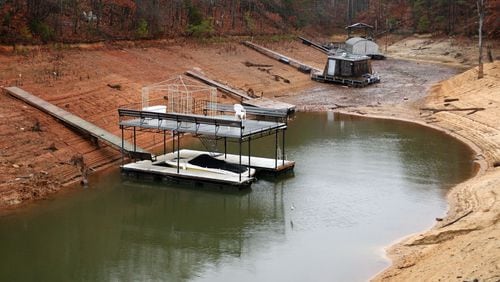Rain has returned to the Southeast region, drawing many areas out of drought conditions. For the first time since mid-September, extreme drought has ended, though areas of moderate to severe drought still exist in several states, including parts of Georgia.
“While there is still some significant drought over North Georgia, it has been improving with regular rain,” said Ryan Willis, meteorologist for the National Weather Service in Peachtree City.
Flash drought conditions have plagued the region this year. In October, some areas received above-average amounts of rain -- up to 6 inches -- but Georgia didn’t get its share.
Notable areas with patchy precipitation are parts of North Georgia from Atlanta to Athens and just north of Augusta to Columbia, South Carolina. “Unfortunately, this was an area that is quite affected by this flash drought, and they basically saw precipitation that was very close to normal levels and in some cases even a little bit below normal,” said Chip Conrad, director of the Southeast Regional Climate Center.
With much of North Georgia under a freeze watch/warning issued by the National Weather Service through Saturday morning, overnight lows are expected to fall into the upper 20s to low 30s, a signal that winter weather is on the way.
It is the time of year when droughts typically improve, Conrad said, but if those areas are not recharged before winter sets in, the conditions may emerge again in the spring.
The drought has also had an impact on water levels in lakes and streams. Georgia experienced record highs and record lows in water amounts over the past month but has since recovered, said Todd Hamill, a hydrologist for the National Weather Service Southeast River Forecast Center. However, in North Georgia, Lake Lanier is almost 3 feet below normal for this time of year, he said.
Georgia farmers have faced challenges with some drought-related crop losses though it is unclear how much they may have lost, said Pam Knox, agricultural climatologist at the University of Georgia.
“The rain that we have seen over the last month has provided some relief to some farmers but not all of them,” she said. Some peanut farmers had trouble getting peanuts out of the ground, while in other areas, heavy rain forced peanuts off the vines and into the ground, which reduced the yields, Knox said.
And the problems are not over yet.
“It is a little deceptive when you get 5 inches (of rain) in a day because a lot of that doesn’t really get into the soil. It just runs right off and so it might be good for the reservoirs, but it doesn’t do a lot for the soil moisture,” Knox said.
Overall, the rain has improved conditions for fall planting and has kept the harvest ahead of normal, but Knox cautions that farmers in southwest Georgia, another area that was missed by rain, may still face big problems in the future.







